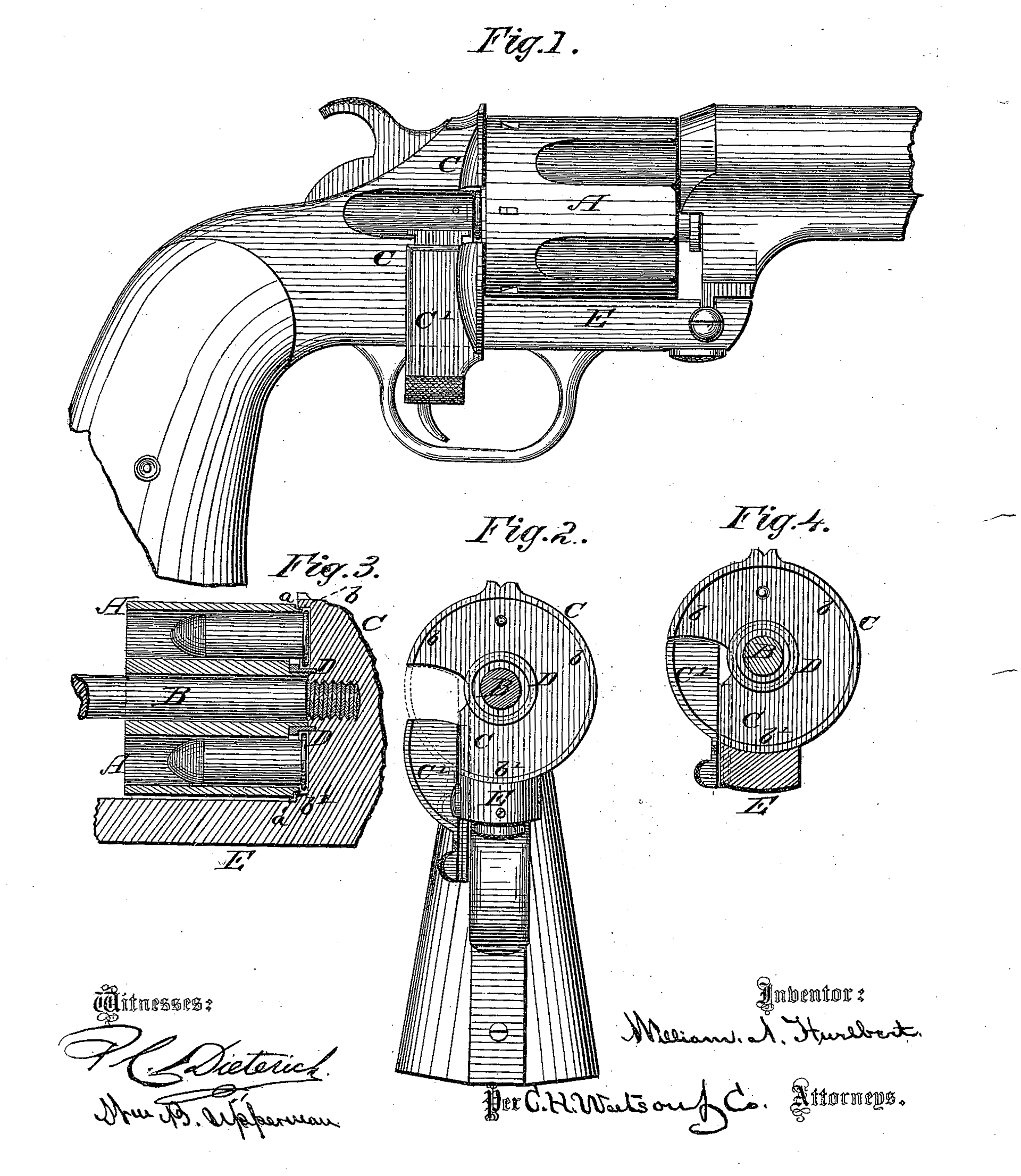US 187975
UNITED STATES PATENT OFFICE.
WILLIAM. A. HULBERT, OF BROOKLYN, NEW YORK.
IMPROVEMENT IN REVOLVING FIRE-ARMS.
Specification forming part of Letters Patent No. 187,975, dated March 6, 1877; application filed December 4, 1876.
To all whom it may concern:
Be it known that I, William A. Hulbert, of Brooklyn, in the county of Kings and State of New York, have invented certain new and useful Improvements in Revolving Fire-Arms; and I do hereby declare the following to be a full, clear, and exact description thereof, reference being had to the accompanying drawings, and to the letters of reference marked thereon.
My invention relates to that class of breech-loading revolving fire-arms, in which the cartridge-shells are simultaneously extracted by means of an annular ring, secured on the axial pin, and entering a recess in the base of the cylinder, behind which ring the flanged heads of the cartridge-shells take; and the nature of my invention consists in a solid recoil-shield with sliding gate, and provided with a projecting rim around its entire circumference, and in the construction of parts, as will be hereinafter more fully set forth.
In order to enable others skilled in the art to which my invention appertains to make and use the same, I will now proceed to describe its construction and operation, referring to the annexed drawings, which form a part of this specification, and in which—
Figure 1 is a side view of a fire-arm embodying my invention. Fig. 2 is a front view of the recoil shield with the gate dropped down. Fig. 3 is a longitudinal section of the cylinder and recoil-shield. Fig. 4 is a front view of the recoil-shield with the gate closed.
A represents the cylinder of a many-chambered revolving fire-arm. B is the axial pin on which the cylinder A revolves, and which pin is provided with the ring-like cartridge-extractor D, that enters a recess in the base of the cylinder. C is the recoil-shield, made solid, and formed with a drop-gate, C’, for Opening and closing the passage or groove through which the cartridges are inserted in the cylinder.
When this gate C^1 is closed the recoil-shield forms a complete circular breech for the fire-arms.
In fire-arms of this class, where the cartridge – shells are to be simultaneously extracted by means of the annular ring D or its equivalent, it often happens that the heads of the cartridges drop away from the extractor, become disengaged from it, and thus fail to be extracted entirely from the cylinder. The cause hereof is that the heads of the cartridges are unconfined at a point opposite the extractor, and hence there is room for them to move laterally.
To obviate this difficulty, I form a forwardly-projecting rim or flange, b, around the entire outer circumference of the recoil-shield, including the drop-gate, which rim or flange confines the heads of the cartridge-shells at points diametrically opposite to the points where they are held by the extractor, and thus prevents them from moving laterally or dropping away from the extractor, and hence insures the complete extraction of them from the cylinder.
It will be noticed that the recoil-shield C is perfectly rigid, and forms a part of the frame of which E is the projecting part immediately below the cylinder. The rim or flange b around the recoil-shield is extended across the top of this part E of the frame, as shown at b’, so as to form a continuous guard around all the cartridge-heads in the cylinder.
The rear end of the cylinder A is cut away at a around its outer edge, to receive the rim or flange b, and allow of the cylinder being brought up close to the recoil-shield. By thus cutting away the rear peripheral edge of the cylinder the general strength thereof is in nowise impaired, but remains intact.
If the extractor ID should be formed on the recoil-shield, so as to grasp the cartridge-heads at their outer edges, the confining-rim or flange b may be formed on the axial pin; but in all cases a bearing should be formed all around for the cartridge-heads, as described.
Having thus fully described my invention, what I claim as new, and desire to secure by Letters Patent, is—
1. In a revolving fire-arm, a rigid recoil shield, C, with gate C’, provided with a forwardly-projecting rim or or flange, b, around its entire circumference, and an annular extractor, substantially as and for the purposes herein set forth.
2. The frame-strap E, provided with the flange or shoulder b’, to form a continuation of the rim b, surrounding the recoil-shield, for the purposes herein set forth.
WM. A. HULBERT.
Witnesses:
Theodore G. Hoster,
B. S. Clark.

